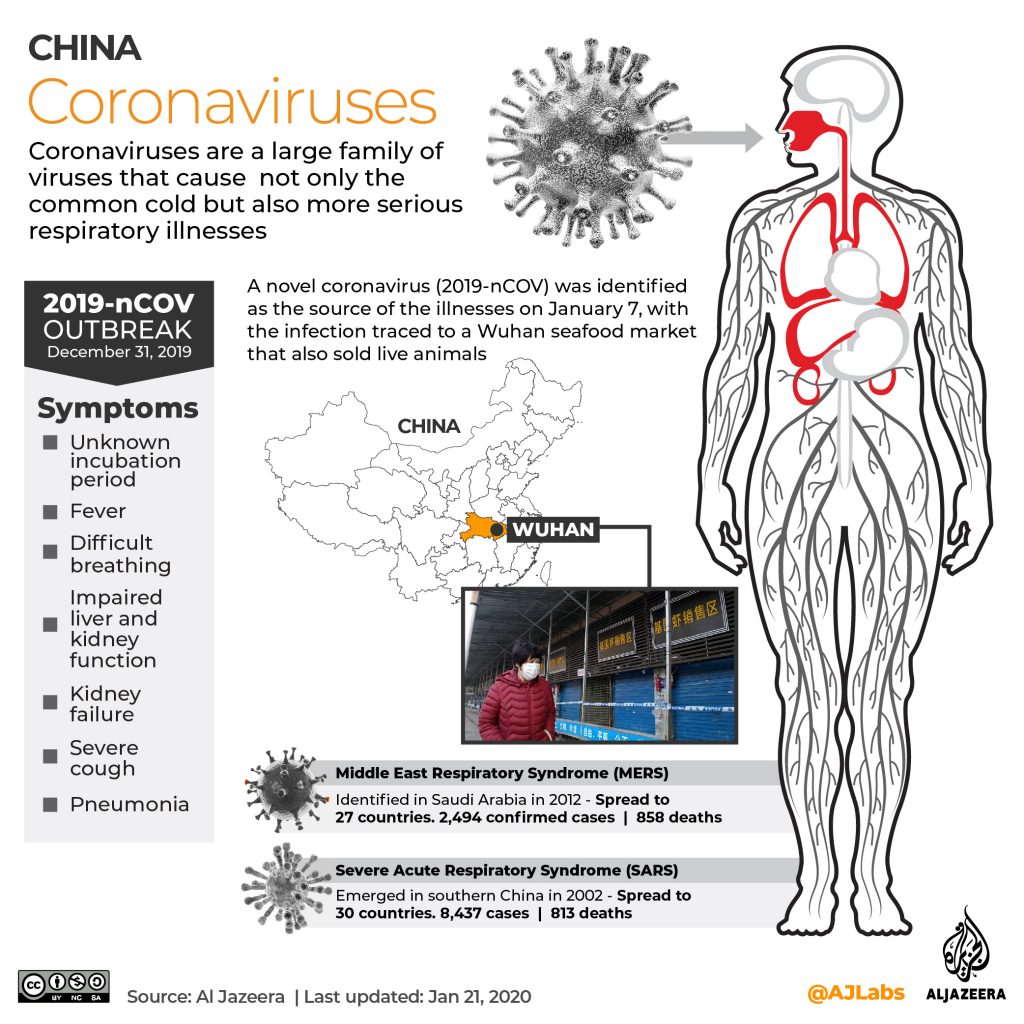China is stepping up efforts to tackle a new coronavirus that is thought to have originated in a Wuhan seafood market.
At least 26 people have died from a new coronavirus in China following an outbreak in the central city of Wuhan.
Almost 830 cases have been reported, the vast majority in the Chinese city.
More:
- UK scientists warn of thousands more China virus infections
- Learning lessons of SARS, countries move quickly to ramp up screening for Wuhan virus
- China reports first death from mysterious outbreak in Wuhan
There are growing concerns about the spread of the virus as hundreds of millions of people travel for the Lunar New Year celebrations, which start on Friday.
Here is what you need to know:
What is coronavirus?
According to the World Health Organization, coronaviruses are a family of viruses that cause illness ranging from the common cold to more severe diseases such as Middle East respiratory syndrome (MERS) and severe acute respiratory syndrome (SARS).
These viruses are transmitted between animals and people. SARS, for instance, was believed to have been transmitted from civet cats to humans while MERS travelled from a type of camel to humans.
Several known coronaviruses are circulating in animals that have not yet infected humans.
The name coronavirus comes from the Latin word corona, meaning crown or halo. Under an electron microscope, the image of the virus is reminiscent of a solar corona.
A novel coronavirus, identified by Chinese authorities on January 7 and currently named 2019-nCoV, is a new strain that had not been previously identified in humans.
Little is known about it, although human-to-human transmission has been confirmed.
What are the symptoms?
According to the WHO, signs of infection include respiratory symptoms, fever, cough, shortness of breath and breathing difficulties.
In more severe cases, it can lead to pneumonia, severe acute respiratory syndrome, kidney failure and even death.
Reports say the incubation period of the coronavirus remains unknown, but other sources say it could be between 10 to 14 days.

How deadly is it?
Some experts say it may not be as deadly as other types of coronavirus such as SARS, which killed nearly 800 people worldwide during a 2002-2003 outbreak that also originated from China.
MERS, which did not spread as widely, was more deadly, killing a third of those it infected.
Where have cases been reported?
Mostly in China.
As of January 24, Chinese officials said at least 26 people have died, all in Hubei Province, of which Wuhan is the capital. That is also where most of the at least 830 reported cases are.
Beyond China, Thailand has reported four cases, Singapore three, Japan two, while South Korea, Taiwan, and the United States have each confirmed one.
All the cases involve people who had either come from Wuhan or been there recently.
What is being done to stop it spreading?
There is no vaccine for the new virus.
Chinese authorities effectively sealed off Wuhan on Thursday, suspending flights and trains out of the city and telling residents they could not leave without a special reason, state media said.
The move was meant to “resolutely contain the momentum of the epidemic spreading” and protect lives, the central city’s special command centre against the virus said, according to state broadcaster CCTV.
At least nine other Chinese cities were added to the transport ban on Friday, affecting more than 20 million people.
Chinese authorities have also stepped up monitoring and disinfection efforts ahead of the Lunar New Year break, which started on Friday and is when many of the country’s 1.4 billion people travel domestically and overseas.
Airport authorities across Asia, including Japan, Hong Kong, Thailand, Singapore, South Korea and Malaysia quickly stepped up screening of passengers from Wuhan.
In Europe, the United Kingdom and Italy have said they will introduce enhanced monitoring of flights from Wuhan, while Romania and Russia are also strengthening checks.
Some airports in the United States have also begun checks.
Where did the virus originate?
Chinese health authorities are still trying to determine the origin of the virus, which they say came from a seafood market in Wuhan where wildlife was also traded illegally.
The WHO also says an animal source appears most likely to be the primary source of the outbreak.
Snakes – including the Chinese krait and the cobra – may be the source of the newly discovered virus, according to Chinese scientists.
There is evidence of respiratory transmission of the virus from patient to patient and Chinese authorities have also said 15 medical staff in the country have been infected.
Experts particularly worry when health workers get sick during new outbreaks because this can suggest the disease is becoming more transmissible and because spread in hospitals can often amplify the epidemic.
Is this a global emergency?
The ourbreak does not yet constitute a global emergency, the WHO said on Thursday, urging China to keep its lockdown of some 20 million people “short”.
WHO chief Tedros Adhanom Ghebreyesus told reporters that the decision to hold off on issuing the declaration used for the gravest epidemics should not be taken as a sign that the body does not think the situation is serious.
“This is an emergency in China, but it has not yet become a global health emergency,” he told reporters.
SOURCE: AL JAZEERA AND NEWS AGENCIES

Putting a spotlight on business, inventions, leadership, influencers, women, technology, and lifestyle. We inspire, educate, celebrate success and reward resilience.















